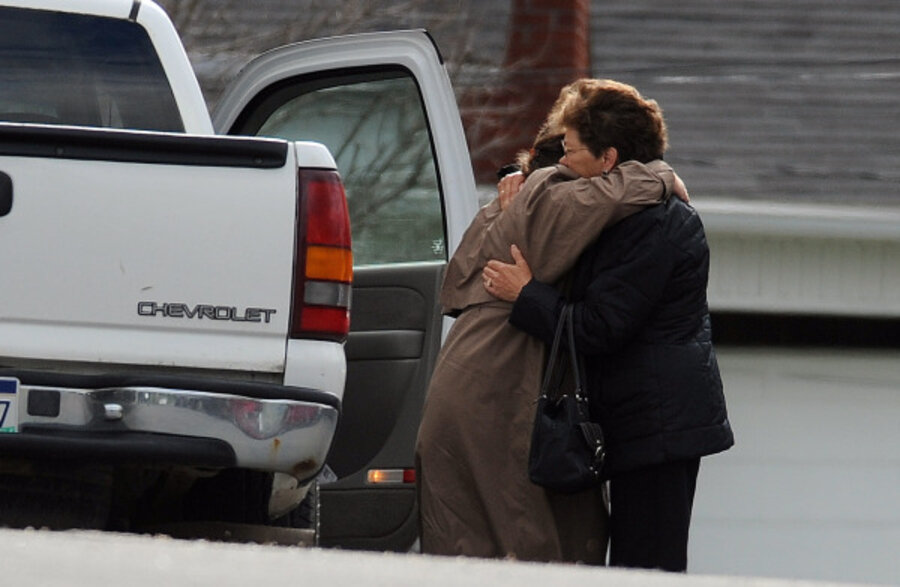Could rescue chambers have saved West Virginia miners?
Loading...
| Chicago
Monday’s explosion at a West Virginia coal mine is becoming a possible test case for the benefit of rescue chambers, which federal legislators mandated all mine operators have installed four years ago to save lives underground in case disaster strikes.
“Mines in this country really haven’t been tested. This is the first test where chambers had been installed,” says Patrick McGinley, a professor of law at West Virginia University who enforced mine safety laws in Pennsylvania as a former special assistant attorney general.
Rescue workers at the Upper Big Branch South Mine in Whitesville have been trying all week to reach two such chambers with hopes of saving four missing miners. An explosion Monday afternoon killed 25 miners and hospitalized two others, in what is considered the worst mining disaster in 25 years.
IN PICTURES: West Virginia mine explosion
The chambers are airtight safe houses that provide four days of clean air for up to 15 people, as well as a supply of food and water, communication and toilet facilities. They are located within 1,000 feet of worker areas and are spaced no more than 30 minutes apart.
Rescue crews were within 500 feet of one chamber Thursday but were ordered back when it was discovered the air was contaminated with high levels of carbon monoxide, methane, and hydrogen gases. A second attempt Friday was similarly stalled due to a fire underway near the chamber.
However, officials from the US Mine Safety and Health Administration (MSHA) said it was determined the first chamber was not deployed and a camera was inserted into the mine to find out the status of the second chamber.
'A sliver of hope'
“We’ve all got one opportunity, a sliver of hope, a miracle if you will, if the other chamber has been deployed, then we have chance,” Kevin Stricklin, a MSHA official, said Friday.
Rescue chambers were not required in mines until the 2006 Mine Improvement and New Emergency Response Act (MINER), a federal mandate that firmed up safety measures in mines as well as emergency response measures such as wireless tracking systems, clearly marked escape routes, and self-rescuing breathing devices.
But safety advocates in the mining industry complain that MSHA was given full authority to require mine operators to install rescue chambers as far back as 1969 when Congress passed the Federal Coal Mine Health and Safety Act, considered a landmark piece of legislation in how comprehensive it was in dealing with safety and health issues. A provision in the law gave MSHA permission to enforce the use of the chambers, but did not rule it mandatory.
Mr. McGinley of West Virginia University says since then, the issue of refuge chambers “was ignored by administration after administration.”
Coal industry authorities had long argued the chambers were unnecessary because it hadn’t been proved that they would work; they also made the argument that determining methods of escaping the mines should be the single priority for all emergency measures and funding.
“MSHA had the authority and the power to require them but they didn’t,” says McGinley. “I attribute that to simply the political and economic power of the coal industry that the industry argued they wouldn’t work, they weren’t economical and the whole concept got lost over time.”
The chambers have since become standard in mines around the world and are considered responsible for saving the lives of nickel miners in Australia and potassium chloride miners in Canada.
Sago disaster forced new mine safety measures
For the US to make them law it took the 2006 mine disaster in Sago, W. Va. that killed 13 miners, a tragedy that forced the passage of the MINER act.
“After Sago it became clear that if [there had been] a refuge chamber, those guys could have gotten in there and survived,” says Larry Grayson a former engineer for Kennedy Metal Products, Inc., which produces one of four chambers approved by the West Virginia Office of Miners’ Health, Safety and Training in 2007.
The legislation provided a safer alternative for miners trapped below ground, says Phil Smith, director of communications for the United Mine Workers of America, in Triangle, Va.
“Prior to the mandate they were taught to build barricades using a ventilation curtain and seal it as best they can and sit there with oxygen units and wait. The problem with that … is that those oxygen units only lasted an hour,” he says.
Mr. Grayson, an engineering professor at Pennsylvania State University and a former mine supervisor, says rescue chambers are designed for workers to reach far from an explosion, but in the Monday incident “they were hit immediately and didn’t have time to travel to the refuge chamber within 1,000 feet.”
He says it is likely that because the explosion was “sudden and violent,” there is little chance the missing miners reached the chamber. That’s why he says, “this will prove not to be a test case at all.”
“Unless we find these guys got into one. In that case, we’ll find out,” he says.





